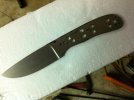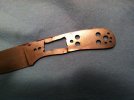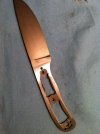- Joined
- Dec 4, 2001
- Messages
- 3,824
here's how I do a full tang knife. I see a lot of people drilling a bunch of holes and tapering the tang. I started out that way, and still taper, but this is how I do mine. Basically I drill 4 smaller holes and use a cut off wheel on the foredom to remove the section. Lots easier and takes more metal out than just drilling holes, and doesn't weaken the knife at all. After tapering and grinding a shallow hollow down the center it makes for a very lively knife when finished.
On the rear there are a few more holes to lighten the knife some more and I tend to put a few groves in with the cut off wheel as well to allow epoxy to flow in better. On the handle slabs I draw out where the cut outs are and drill a bunch of shallow holes to allow more room for epoxy and to undercut a bit for a mechanical lock with the epoxy.
I'm sure it's nothing new, but maybe help some new makers out trying to figure out how to lighten the handle up. Just leave plenty of metal around the pin area's and more metal towards the front of the knife for strength.
On the rear there are a few more holes to lighten the knife some more and I tend to put a few groves in with the cut off wheel as well to allow epoxy to flow in better. On the handle slabs I draw out where the cut outs are and drill a bunch of shallow holes to allow more room for epoxy and to undercut a bit for a mechanical lock with the epoxy.
I'm sure it's nothing new, but maybe help some new makers out trying to figure out how to lighten the handle up. Just leave plenty of metal around the pin area's and more metal towards the front of the knife for strength.




